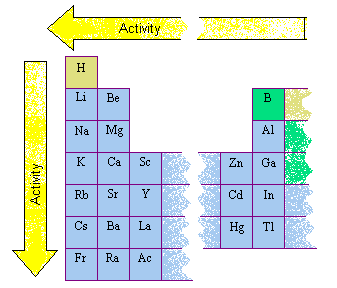Which Metals Are Most Reactive
Activity of Metals The Activity of Metals The primary deviation between metals is the ease with which they undergo chemical reactions. The elements toward the lesser left corner of the periodic table are the metals that are the most agile in the sense of being the most reactive. Lithium, sodium, and potassium all react with water, for example. The rate of this reaction increases as we go down this cavalcade, however, considering these elements become more active as they become more metal. Classifying Metals Based on Activeness The metals are often divided into four classes on the basis of their action, as shown in the tabular array below. Common Metals Divided into Classes on the Basis of Their Activity The virtually active metals are and then reactive that they readily combine with the Oii and H2O vapor in the atmosphere and are therefore stored under an inert liquid, such as mineral oil. These metals are found exclusively in Groups IA and IIA of the periodic tabular array. Metals in the second class are slightly less active. They don't react with water at room temperature, only they react speedily with acids. The third class contains metals such every bit chromium, iron, tin, and pb, which react only with strong acids. It also contains even less active metals such equally copper, which only dissolves when treated with acids that can oxidize the metal. Metals in the fourth class are so unreactive they are essentially inert at room temperature. These metals are ideal for making jewelry or coins because they practise non react with the vast majority of the substances with which they come up into daily contact. Every bit a result, they are frequently called the "coinage metals." Predicting the Product of Main Group Metal Reactions The production of many reactions betwixt main group metals and other elements can be predicted from the electron configurations of the elements. Case: Consider the reaction betwixt sodium and chlorine to class sodium chloride. It takes more energy to remove an electron from a sodium cantlet to form an Na+ ion than we get back when this electron is added to a chlorine cantlet to course a Cl- ion. In one case these ions are formed, nevertheless, the strength of attraction between these ions liberates enough energy to make the following reaction exothermic. The cyberspace upshot of this reaction is to transfer one electron from a neutral sodium atom to a neutral chlorine atom to form Na+ and Cl- ions that have filled-beat configurations. Potassium and hydrogen have the following electron configurations. When these elements react, an electron has to be transferred from one element to the other. We can decide which element should lose an electron by comparing the first ionization energy for potassium (418.eight kJ/mol) with that for hydrogen (1312.0 kJ/mol). Potassium is much more than likely to lose an electron in this reaction, which ways that hydrogen gains an electron to form Yard+ and H- ions.

![]()
Class I Metals: The Active Metals Li, Na, K, Rb, Cs (Group IA) Ca, Sr, Ba (Group IIA) Course II Metals: The Less Active Metals Mg, Al, Zn, Mn Class III Metals: The Structural Metals Cr, Fe, Sn, Pb, Cu Class IV Metals: The Coinage Metals Ag, Au, Pt, Hg ![]()
![]()
![]()
![]()
Which Metals Are Most Reactive,
Source: https://chemed.chem.purdue.edu/genchem/topicreview/bp/ch9/activity.php
Posted by: turneraloold.blogspot.com


0 Response to "Which Metals Are Most Reactive"
Post a Comment